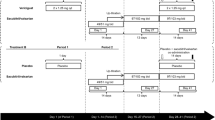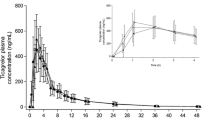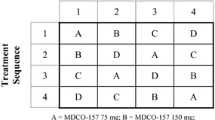Abstract
Purpose
Ticagrelor is a reversibly binding P2Y12 receptor antagonist for the prevention of atherothrombotic events in patients with acute coronary syndrome. Previous in vitro studies showed that ticagrelor is a substrate and inhibitor of P-glycoprotein (ABCB1). Therefore, we examined the potential interaction between digoxin, a P-glycoprotein substrate, and ticagrelor by evaluating the pharmacokinetics, safety, and tolerability.
Methods
This was a randomized, double-blind, two-period crossover study in healthy volunteers (n = 20). Pharmacokinetic parameters of digoxin and ticagrelor were evaluated following co-administration of ticagrelor 400 mg qd or placebo on days 1–16, and digoxin (0.25 mg bid on day 6 and 0.25 mg qd on days 7–14).
Results
Co-administration of ticagrelor increased the digoxin maximum plasma concentration by 75 %, from 1.8 ng/ml to 3.0 ng/ml (Gmean ratio [GMR] 1.75 [95 % CI, 1.52–2.01]); minimum plasma concentration by 31 %, from 0.5 ng/ml to 0.7 ng/ml (GMR 1.31, 1.13–1.52); and mean area under the curve by 28 %, from 16.8 ng · h/ml to 21.0 ng · h/ml (GMR 1.28, 1.12–1.46), compared with placebo. Renal clearance of digoxin was unaffected by the presence of ticagrelor. Digoxin had no effect on the pharmacokinetics of ticagrelor or its active metabolite, AR-C124910XX. Co-administration of ticagrelor and digoxin was well tolerated.
Conclusions
Collectively, these results indicate that ticagrelor is a weak inhibitor of the P-glycoprotein transporter. Based on these findings, it is recommended that serum concentrations of drugs like digoxin (P-glycoprotein transporter substrates with a narrow therapeutic range) are monitored when initiating or changing ticagrelor therapy.




Similar content being viewed by others
References
Husted S, van Giezen JJ (2009) Ticagrelor: the first reversibly binding oral P2Y12 receptor antagonist. Cardiovasc Ther 27:259–274
Butler K, Teng R (2010) Pharmacokinetics, pharmacodynamics, safety and tolerability of multiple ascending doses of ticagrelor in healthy volunteers. Br J Clin Pharmacol 70:65–77
Teng R, Butler K (2010) Pharmacokinetics, pharmacodynamics, tolerability and safety of single ascending doses of ticagrelor, a reversibly binding oral P2Y(12) receptor antagonist, in healthy subjects. Eur J Clin Pharmacol 66:487–496
Teng R, Butler K (2008) AZD6140, the first reversible oral platelet P2Y12 receptor antagonist, has linear pharmacokinetics and provides near complete inhibition of platelet aggregation, with reversibility of effect, in healthy subjects. Can J Clin Pharmacol 15:e426
Husted S, Emanuelsson H, Heptinstall S, Sandset PM, Wickens M, Peters G (2006) Pharmacodynamics, pharmacokinetics, and safety of the oral reversible P2Y12 antagonist AZD6140 with aspirin in patients with atherosclerosis: a double-blind comparison to clopidogrel with aspirin. Eur Heart J 27:1038–1047
Storey RF, Husted S, Harrington RA, Heptinstall S, Wilcox RG, Peters G, Wickens M, Emanuelsson H, Gurbel P, Grande P, Cannon CP (2007) Inhibition of platelet aggregation by AZD6140, a reversible oral P2Y12 receptor antagonist, compared with clopidogrel in patients with acute coronary syndromes. J Am Coll Cardiol 50:1852–1856
Savi P, Combalbert J, Gaich C, Rouchon MC, Maffrand JP, Berger Y, Herbert JM (1994) The antiaggregating activity of clopidogrel is due to a metabolic activation by the hepatic cytochrome P450–1A. Thromb Haemost 72:313–317
Teng R, Oliver S, Hayes MA, Butler K (2010) Absorption, distribution, metabolism, and excretion of ticagrelor in healthy subjects. Drug Metab Dispos 38:1514–1521
Zhou D, Andersson TB, Grimm SW (2011) In vitro evaluation of potential drug-drug interactions with ticagrelor: cytochrome P450 reaction phenotyping, inhibition, induction and differential kinetics. Drug Metab Dispos 39:703–710
von Richter O, Burk O, Fromm MF, Thon KP, Eichelbaum M, Kivisto KT (2004) Cytochrome P450 3A4 and P-glycoprotein expression in human small intestinal enterocytes and hepatocytes: a comparative analysis in paired tissue specimens. Clin Pharmacol Ther 75:172–183
Glaeser H (2011) Importance of P-glycoprotein for drug-drug interactions. Handb Exp Pharmacol 201:285–297
Taneva E, Bogdanova V, Shtereva N (2004) Acute coronary syndrome, comorbidity, and mortality in geriatric patients. Ann N Y Acad Sci 1019:106–110
Tanigawara Y, Okamura N, Hirai M, Yasuhara M, Ueda K, Kioka N, Komano T, Hori R (1992) Transport of digoxin by human P-glycoprotein expressed in a porcine kidney epithelial cell line (LLC-PK1). J Pharmacol Exp Ther 263:840–845
de Lannoy I, Silverman M (1992) The MDR1 gene product, P–glycoprotein, mediates the transport of the cardiac glycoside, digoxin. Biochem Biophys Res Commun 189:551–557
Drescher S, Glaeser H, Murdter T, Hitzl M, Eichelbaum M, Fromm MF (2003) P–glycoprotein-mediated intestinal and biliary digoxin transport in humans. Clin Pharmacol Ther 73:223–231
Food and Drug Administration. Guidance for industry: Drug interaction studies – study design, data analysis, implications for dosing, and labeling (Feb 2012) http://www.fda.gov/downloads/Drugs/GuidanceComplianceRegulatoryInformation/Guidances/ucm292362.pdf. Accessed 11 October 2012
Greiner B, Eichelbaum M, Fritz P, Kreichgauer HP, von Richter O, Zundler J, Kroemer HK (1999) The role of intestinal P-glycoprotein in the interaction of digoxin and rifampin. J Clin Invest 104:147–153
Food and Drug Administration. New Drug Application #22433, Appendix 1: clinical pharmacology and biopharmaceutics review (2010) http://www.accessdata.fda.gov/drugsatfda_docs/nda/2011/022433Orig1s000ClinPharmR.pdf. Accessed 30 January 2013
Englund G, Hallberg P, Artursson P, Michaelsson K, Melhus H (2004) Association between the number of coadministered P-glycoprotein inhibitors and serum digoxin levels in patients on therapeutic drug monitoring. BMC Med 2:8
Morris SA, Hatcher HF, Reddy DK (2006) Digoxin therapy for heart failure: an update. Am Fam Physician 74:613–618
Rathore SS, Curtis JP, Wang Y, Bristow MR, Krumholz HM (2003) Association of serum digoxin concentration and outcomes in patients with heart failure. JAMA 289:871–878
Mahmud A, Bennett K, Okechukwu I, Feely J (2007) National underuse of anti-thrombotic therapy in chronic atrial fibrillation identified from digoxin prescribing. Br J Clin Pharmacol 64:706–709
Lip GY, Huber K, Andreotti F, Arnesen H, Airaksinen KJ, Cuisset T, Kirchhof P, Marin F (2010) Management of antithrombotic therapy in atrial fibrillation patients presenting with acute coronary syndrome and/or undergoing percutaneous coronary intervention/ stenting. Thromb Haemost 103:13–28
NICE. Clinical guideline 36: Atrial Fibrillation—the management of atrial fibrillation. http://www.nice.org.uk/nicemedia/live/10982/30052/30052.pdf Accessed 16 May 2012
Camm AJ, Kirchhof P, Lip GY, Schotten U, Savelieva I, Ernst S, Van Gelder IC, Al-Attar N, Hindricks G, Prendergast B, Heidbuchel H, Alfieri O, Angelini A, Atar D, Colonna P, De Caterina R, De Sutter J, Goette A, Gorenek B, Heldal M, Hohloser SH, Kolh P, Le Heuzey JY, Ponikowski P, Rutten FH (2010) Guidelines for the management of atrial fibrillation: the Task Force for the Management of Atrial Fibrillation of the European Society of Cardiology (ESC). Eur Heart J 31:2369–2429
Schmitt J, Duray G, Gersh BJ, Hohnloser SH (2009) Atrial fibrillation in acute myocardial infarction: a systematic review of the incidence, clinical features and prognostic implications. Eur Heart J 30:1038–1045
Sillén H, Cook M, Davis P (2010) Determination of ticagrelor and two metabolites in plasma samples by liquid chromatography and mass spectrometry. J Chromatogr B Analyt Technol Biomed Life Sci 878:2299–2306
Taylor A, Beerahee A, Citerone D, Davy M, Fitzpatrick K, Lopez-Gil A, Stocchi F (1999) The effect of steady-state ropinirole on plasma concentrations of digoxin in patients with Parkinson’s disease. Br J Clin Pharmacol 47:219–222
Schwartz JI, Agrawal NG, Wehling M, Musser BJ, Gumbs CP, Michiels N, De SM, Wagner JA (2008) Evaluation of the pharmacokinetics of digoxin in healthy subjects receiving etoricoxib. Br J Clin Pharmacol 66:811–817
Brilique, summary of product characteristics (2010) http://www.ema.europa.eu/docs/en_GB/document_library/EPAR_-_Product_Information/human/001241/WC500100494.pdf. Accessed 16 February 2012
BrilintaTM US full prescribing information (July 2011) http://www.accessdata.fda.gov/drugsatfda_docs/label/2011/022433s000lbl.pdf. Accessed16 February 2012
Fuster V, Ryden LE, Cannom DS, Crijns HJ, Curtis AB, Ellenbogen KA, Halperin JL, Le Heuzey JY, Kay GN, Lowe JE, Olsson SB, Prystowsky EN, Tamargo JL, Wann S, Smith SC Jr, Jacobs AK, Adams CD, Anderson JL, Antman EM, Halperin JL, Hunt SA, Nishimura R, Ornato JP, Page RL, Riegel B, Priori SG, Blanc JJ, Budaj A, Camm AJ, Dean V, Deckers JW, Despres C, Dickstein K, Lekakis J, McGregor K, Metra M, Morais J, Osterspey A, Tamargo JL, Zamorano JL (2006) ACC/AHA/ESC 2006 Guidelines for the Management of Patients with Atrial Fibrillation: a report of the American College of Cardiology/American Heart Association Task Force on Practice Guidelines and the European Society of Cardiology Committee for Practice Guidelines (Writing Committee to Revise the 2001 Guidelines for the Management of Patients With Atrial Fibrillation): developed in collaboration with the European Heart Rhythm Association and the Heart Rhythm Society. Circulation 114:e257–e354
Dickstein K, Cohen-Solal A, Filippatos G, McMurray JJ, Ponikowski P, Poole-Wilson PA, Strömberg A, van Veldhuisen DJ, Atar D, Hoes AW, Keren A, Mebazaa A, Nieminen M, Priori SG, Swedberg K, ESC Committee for Practice Guidelines (CPG) (2008) ESC guidelines for the diagnosis and treatment of acute and chronic heart failure 2008: the Task Force for the diagnosis and treatment of acute and chronic heart failure 2008 of the European Society of Cardiology. Developed in collaboration with the Heart Failure Association of the ESC (HFA) and endorsed by the European Society of Intensive Care Medicine (ESICM). Eur J Heart Fail 10:933–989
Ansell J, Hirsh J, Hylek E, Jacobson A, Crowther M, Palareti G (2008) Pharmacology and management of the vitamin K antagonists: American College of Chest Physicians Evidence-based Clinical Practice Guidelines (8th edition). Chest 133:160S–198S
Miura T, Kojima R, Sugiura Y, Mizutani M, Takatsu F, Suzuki Y (2000) Effect of aging on the incidence of digoxin toxicity. Ann Pharmacother 34:427–432
Digoxin Tablets [prescribing information]. West-ward Pharmaceutical Corp. Eatontown, NJ. July 2010. http://druginserts.com/lib/rx/meds/digoxin-18/. Accessed 16 February 2012
Siepmann M, Kleinbloesem C, Kirch W (1995) The interaction of the calcium antagonist RO 40–5967 with digoxin. Br J Clin Pharmacol 39:491–496
Acknowledgments
The authors wish to thank Kenneth Lasseter (lead investigator) and the team at the clinical pharmacology unit for conducting the study. Staff at York Bioanalytical Solutions (York, UK) and PPD Development (Richmond, VA, USA) are acknowledged for their contribution to the pharmacokinetic sample analyses. Statistical support was provided by Stephanie Dunbar, PhD. Editorial support in the preparation of this manuscript was provided by David Evans, PhD (Medical Writer, Gardiner-Caldwell Communications).
Funding sources
Editorial support was funded by AstraZeneca.
Authors’ contributions
Both authors participated in research design, performed the data analysis, and wrote or contributed to the writing of the manuscript.
Conflicts of interest
This study was funded by AstraZeneca. The authors are employees of AstraZeneca.
Author information
Authors and Affiliations
Corresponding author
Electronic supplementary material
Below is the link to the electronic supplementary material.
ESM 1
(DOCX 14 kb)
Rights and permissions
About this article
Cite this article
Teng, R., Butler, K. A pharmacokinetic interaction study of ticagrelor and digoxin in healthy volunteers. Eur J Clin Pharmacol 69, 1801–1808 (2013). https://doi.org/10.1007/s00228-013-1543-3
Received:
Accepted:
Published:
Issue Date:
DOI: https://doi.org/10.1007/s00228-013-1543-3




